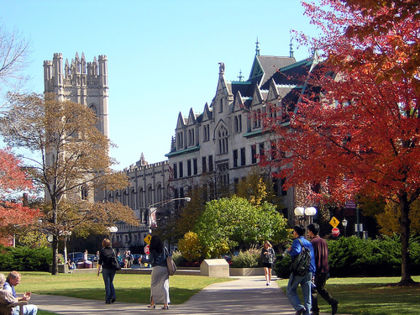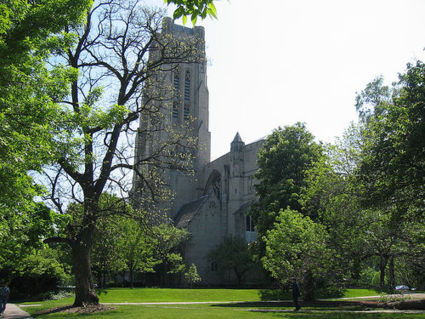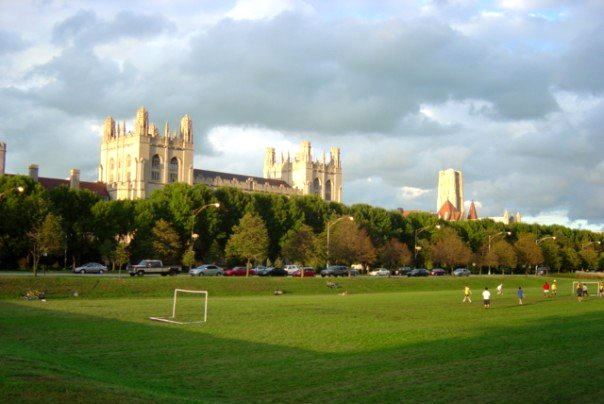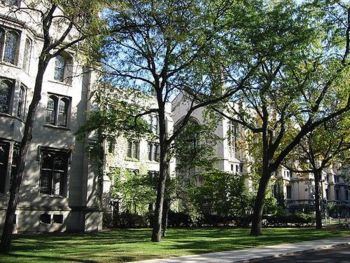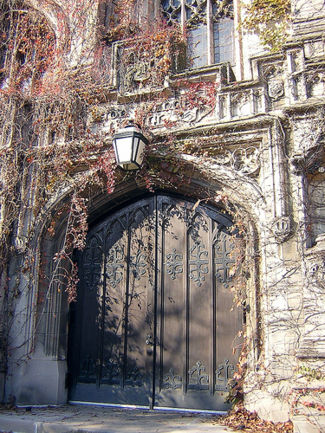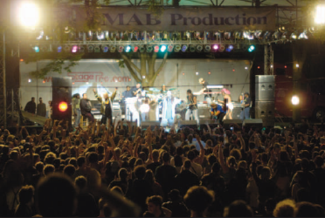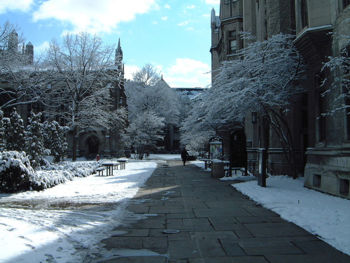University of Chicago
2007 Schools Wikipedia Selection. Related subjects: North American Geography
 |
|
| Motto | Crescat scientia; vita excolatur (Latin for "Let knowledge grow from more to more; and so be human life enriched") |
|---|---|
| Established | 1890 by John D. Rockefeller |
| Type | Private coeducational |
| Endowment | $4.8 billion |
| President | Robert J. Zimmer |
| Faculty | 2,160 |
| Staff | 12,460 (includes Hospitals) |
| Undergraduates | 4,391 |
| Postgraduates | 9,110 |
| Location | Chicago, Illinois, USA |
| Campus | Urban, 211 acres (850,000 m²) |
| Colors | Maroon and White |
| Nickname | Maroons |
| Mascot | Phoenix |
| Website | www.uchicago.edu |
The University of Chicago is a private university located principally in the Hyde Park neighbourhood of Chicago. Founded in 1890 by oil magnate John D. Rockefeller, the University of Chicago held its first classes on October 1, 1892. Chicago was one of the first universities in the country to be conceived as a combination of the American interdisciplinary liberal arts college and the German research university.
The University of Chicago is widely recognized as one of the world's foremost universities. The university is affiliated with 79 Nobel Prize laureates. Particularly notable are the university's 27 laureates in physics and 23 laureates in economics. Historically, the university is noted for its unique undergraduate core curriculum as well as other educational innovations pioneered by Robert Maynard Hutchins in the 1930s (including the academic quarter system), and for influential academic movements such as the " Chicago School of Economics", the " Chicago School of Sociology," the " Chicago School of Literary Criticism," and the law and economics movement in legal analysis. The University of Chicago was the site of the world's first self-sustained nuclear reaction. It is also home to the largest university press in the country.
Campus overview
The University of Chicago is principally located seven miles south of downtown Chicago, in the neighborhoods of Hyde Park and Woodlawn. The University of Chicago's campus is bisected by Frederick Law Olmsted's Midway Plaisance, a large linear park created for the 1893 World's Fair. The bulk of the campus, including the Main Quadrangle, is located north of the Midway, while several of the professional schools are located south of the Midway. The university's campus is noted for its neo-Gothic architecture, which was constructed entirely out of limestone in the late 19th century, and is complemented by the Main Quandrangles' status as a botanical garden. The buildings of the original quadrangles were deliberately patterned after the layouts of Oxford University and Cambridge University. Mitchell Tower, for example, is a smaller-sized reproduction of Oxford's Magdalen Tower, and the University Commons, Hutchinson Hall, is a duplicate of Oxford's Christ Church Hall.
Contemporary buildings have attempted to complement the style of the original architecture, with varying degrees of success. One of the most striking modern additions is the Regenstein Library, designed by architect Walter Netsch and constructed on the grounds of the former Stagg Field, the site of the world's first nuclear reaction. The campus is also home to Rockefeller Chapel, designed by Bertram Goodhue, and the Robie House, designed by Frank Lloyd Wright.
A recent two billion dollar campaign has brought unprecedented expansion to the university, including: the unveiling of the Max Palevsky Residential Commons, the Gerald Ratner Athletics Centre, a new hospital, and a new science building. The Jules and Gwen Knapp Center for Biomedical Discovery, a ten-story medical research centre, as well as further additions to the medical campus are currently under construction.. The university plans to direct the next stage of its campaign towards revamping and consolidating dormitories, some of which are far from campus and aging poorly. Plans are underway for the construction of a new dormitory on land south of the Midway Plaisance.
The university also maintains several facilities apart from its main campus. The university's Graduate School of Business maintains campuses in Singapore, London and in the Chicago Loop, while the Paris Centre, a campus located on the left bank of the River Seine in Paris, hosts various undergraduate and graduate study programs.
Moreover, the university's Yerkes Observatory, in Williams Bay, Wisconsin constructed in 1897, is home to the largest refracting telescope ever built. Although Yerkes was never able to match the observation conditions afforded by the mountaintop location of its main competitor, the Lick Observatory, Yerkes was a leader in astrophysics. It was at Yerkes that the spiral structure the Milky Way Galaxy was first demonstrated, and carbon first discovered in stellar spectra.
The campus is furthermore home to the Oriental Institute, an internationally renowned archeology museum and research centre for ancient Near Eastern studies. The Institute is housed in an unusual Gothic and Art Deco building designed by the architectural firm Mayers Murray & Phillip. The Museum has artifacts from digs in Egypt, Israel, Syria, Turkey, Iraq, and Iran. Notable possessions include the famous Megiddo Ivories, various treasures from Persepolis, the old Persian capital, a 40-ton human-headed winged bull from Khorsabad, the capital of Sargon II, and a monumental statue of King Tutankhamun.
Across the street from Oriental Institute is the Seminary Co-op book store. The labyrinthine Co-op, located in the basement of the Chicago Theological Seminary on University Avenue, stocks the largest selection of academic volumes in the United States.
History
Much of the information below is adapted from the University of Chicago's official website.
The University of Chicago was founded by oil magnate John D. Rockefeller, who later called it "the best investment I ever made." The University's founding was part of a wave of university foundings that followed the American Civil War. Incorporated in 1890, the University has dated its founding as July 1, 1891, when William Rainey Harper became its first president. The first classes were held on October 1, 1892, with an enrollment of 594 students and a faculty of 120, including eight former college presidents.
Westward migration, population growth, and industrialization led to an increasing need for elite schools away from the East Coast, especially schools whose focus would be on issues vital to national development. Though Rockefeller was urged to build in New England or the Mid-Atlantic region of the United States, he ultimately chose Chicago. His choice reflected his strong desire to realize Thomas Jefferson's dream of a natural meritocracy's rise to prominence, determined by talent rather than familial heritage. Rockefeller's early fiscal emphasis on the physics department showed his pragmatic, yet deeply intellectual, desires for the school.
Though founded under Baptist auspices, Chicago has never had a sectarian affiliation. The school's traditions of rigorous scholarship were established primarily by Presidents William Rainey Harper and Robert Maynard Hutchins. Chicago opened its door to women and minorities from the very beginning, at a time when their access to other leading universities was extremely rare. It was the first major university to enroll women on an equal basis with men , as well as the first major, predominantly white university to offer a black professor a tenured post circa 1947.
Unlike many other American universities at the time (with the notable exception of Johns Hopkins), the University of Chicago was set up around a number of graduate research institutions, following Germanic precedent. The college itself remained quite small compared to its East Coast peers until around the middle of the 20th century.
As a result, the graduate population of the university, to this day, dwarfs the undergraduate population 2:1, while the university's undergraduate student body remains the third smallest amongst the top 10 national universities. The student-to-faculty ratio is also one of the lowest amongst national universities, at 4:1, and all faculty members are required to teach undergraduate courses.
During his presidency, Robert Maynard Hutchins met with the president of rival Northwestern University to discuss the future of the two institutions through the Depression and the looming war. Hutchins concluded that, in order to secure the future of both universities, it was in the best interest of both for the two campuses to merge as the Universities of Chicago, with Northwestern's campus serving as the site for undergraduate education, and the Hyde Park campus serving as the graduate studies campus. President Hutchins' vision for what he hoped would become the preeminent university in the world was eventually quashed by Northwestern University's board of trustees, a result that Hutchins called "one of the lost opportunities of American education."
As part of the Manhattan Project, University of Chicago chemists, led by Glenn T. Seaborg, began to study the newly manufactured radioactive element, plutonium. The George Herbert Jones Laboratory was the site where, for the first time, a trace quantity of this new element was isolated and measured in September 1942. This procedure enabled chemists to determine the new element's atomic weight. Room 405 of the building was named a National Historic Landmark in May 1967.
On December 2, 1942, the world's first self-sustained nuclear reaction was achieved at Stagg Field on the campus of the university under the direction of professor Enrico Fermi. A sculpture by Henry Moore marks the location where the nuclear reaction took place (now deemed a National Historic Landmark). Stagg Field has since been demolished to make way for the Regenstein Library.
In addition to its groundbreaking work involving nuclear energy, the University of Chicago is also recognized for numerous other significant discoveries, including:
- The technique of carbon-14 dating, developed in 1949 by Willard Frank Libby and his team during his tenure as a professor at the university. Libby was awarded the Nobel Prize in Chemistry in 1960 for this discovery.
- The discovery of the atmosphere's jet stream.
- The discovery of REM sleep.
- The procedure for the nation's first living-donor liver transplant.
- The famous Miller-Urey experiment, considered to be the classic experiment on the origin of life.
- The development of agent orange, a highly-toxic herbicide that would gain notoriety for its use during the Vietnam War.
In 1955, the University of Chicago became the birthplace of improvisational comedy with the formation of the undergraduate comedy troupe, the Compass Players.
In 1978, Hanna Holborn Gray, then the provost of Yale University, became President of the university, the first woman ever to serve as the president of a major research university.
In 1999, then-President Hugo Sonnenschein announced plans to relax the university's famed core curriculum, including reducing the number of required courses from 21 to 15. When The New York Times, The Economist, and other major news outlets picked up this story, the university became the focal point of a national debate on education. The National Association of Scholars, for example, released a statement saying, "It is truly depressing to observe a steady abandonment of the University of Chicago's once imposing undergraduate core curriculum, which for so long stood as the benchmark of content and rigor among American academic institutions." The changes were ultimately implemented, but the controversy led to Sonnenschein's resignation in 2000.
In 2006, the University of Chicago's Oriental Institute became the centre of controversy when U.S. federal courts ruled to seize and auction its valuable collection of ancient Persian artifacts, the proceeds of which would go to compensate the victims of a 1997 bombing in Jerusalem that the United States claim was funded by Iran. The ruling threatens the university's invaluable collection of ancient clay tablets held by the Oriental Institute since the 1930s but officially owned by Iran.
Academics
Specific programs
The University of Chicago's economics department is particularly well-known. In fact, an entire school of thought (the Chicago School of Economics) bears its name. Led by Nobel Prize laureates such as Milton Friedman, Ronald Coase, George Stigler, Gary Becker, Robert Lucas, James Heckman, and Robert Fogel, the university's economics department has played an important role in shaping ideas about the free market. The Chicago School of Economics is also famous for applying economic principles to every aspect of human life, as famously demonstrated by Steven Levitt in his best-selling book, Freakonomics.
The university is also known for creating the first sociology department in the United States, which later gave birth to the Chicago School of Sociology. Scholars affiliated with this school are considered pioneers in the field and include Albion Small, George Herbert Mead, Robert E. Park, W. I. Thomas, and Ernest Burgess.
The university is home to several committees for interdisciplinary scholarship, the most famous of which is the Committee on Social Thought. One of several Ph.D-granting committees at the university, it was started in 1941 by University of Chicago president Robert Maynard Hutchins along with historian John U. Nef, economist Frank Knight, and anthropologist Robert Redfield. The committee is interdisciplinary, but it is not centered on any specific topic. Since its inception, the committee has drawn together noted academics and writers to "foster awareness of the permanent questions at the origin of all learned inquiry". Members of this program have included Hannah Arendt, T. S. Eliot, Leo Strauss, Allan Bloom, Nathan Tarcov, Friedrich von Hayek, Leon Kass, Mark Strand, Wayne Booth, and J.M. Coetzee.
In 1983, the University of Chicago implemented the University of Chicago School Mathematics Project, a comprehensive mathematics program for students from kindergarten through twelfth grade. Today, an estimated 3.5 to 4 million students in elementary and secondary schools in every state and virtually every major urban area are now using UCSMP materials.
Divisions and schools
|
Divisions
|
Schools
|
Other Academic Institutions
|
Title VI Area Centers
|
The University of Chicago currently maintains twelve units: the College, four divisions of graduate research, six professional schools, and the Graham School of General Studies. The University of Chicago also operates the Library, the Press, the Lab Schools, and the Hospitals.
Faculty and students at the adjacent Toyota Technological Institute at Chicago also collaborate closely with the university. Although formally unrelated, the National Opinion Research Centre is also located on the campus, with many faculty members and graduate students holding research appointments at NORC.
The university also operates the University of Chicago Laboratory Schools (from day care through high school, founded by John Dewey and considered one of the leading preparatory schools in the United States), the Hyde Park Day Schools (for the learning disabled of otherwise exceptional ability), and the Orthogenic School (a residential treatment program for those with behavioural and emotional problems). The university also administers two unaffiliated public charter schools on the South Side of Chicago.
The University of Chicago Press is the largest university press in the country. It publishes a wide array of scholarly and academic texts, including the influential Chicago Manual of Style, as well as several academic journals (including Critical Inquiry).
The University of Chicago's library system is also one of the largest in the country. The university's Regenstein Library is committed to providing physical, "browsable" access to print books in a single location, rather than relying on offsite storage as many libraries do. A planned expansion will raise its collection from 6.5 million volumes to 8 million volumes, surpassing the University of Illinois at Urbana-Champaign (currently the largest with 7.5 million volumes onsite) and making the Regenstein the largest such university library in the United States. In 2005, funding was approved for the construction of a 38,000-square-foot addition to the library in order to accommodate the collection's expansion. It is scheduled to be completed by winter of 2009. The "Reg", as it is commonly called by students, is noted for its exceptional breadth and depth of material. Within its 2007 rankings, the Princeton Review ranked it among the top three college libraries in the country.
The John Crerar Library is recognized as one of the best libraries in the country for research and teaching in the sciences, medicine, and technology. Completing the science quadrangle is the Kersten Physics Teaching Centre, which is recognized as the most advanced facility in the U.S. for the teaching of undergraduate physics. Students in the College have access to all of the university’s special libraries, including the D’Angelo Law Library, Yerkes Observatory Library for astronomy and astrophysics, the Social Service Administration Library, and the Eckhart Library for mathematics and computer science.
Chicago also operates a number of off-campus scientific research institutions, including the Argonne National Laboratory, part of the United States Department of Energy's national laboratory system. The university also owns and operates the Oriental Institute and has a stake in the Apache Point Observatory in Sunspot, New Mexico. It is also a founding member of the Committee on Institutional Cooperation.
In February 2006, the University of Chicago announced its bid for a U.S. Department of Energy contract to obtain complete management rights to the Fermi National Accelerator Laboratory, which maintains the Tevatron, the world's highest-energy particle accelerator. Fermilab is currently one of the world's primary scientific research centers in the fields of elementary particle physics and astrophysics.
Undergraduate college
The centerpiece of the University of Chicago is the undergraduate college, known as the College of the University of Chicago. The majority of undergraduate courses are small, discussion-based seminars, and undergraduate students routinely take their upper-level courses alongside graduate students.
The College of the University of Chicago grants Bachelor of Arts and Bachelor of Science degrees in 52 majors and 14 minors in the biological, physical, and social sciences, as well as in the humanities and interdisciplinary areas. A major may provide a comprehensive understanding of a well-defined field, such as anthropology or mathematics, or it may be an interdisciplinary program such as African and African-American studies, environmental studies, biological chemistry, or cinema and media studies. A full list of offered majors and minors is available within the college's main article.
Undergraduate students must undergo a rigorous core curriculum, the goal of which is to impart an education that is both timeless and a vehicle for interdisciplinary debate. Students must take courses designed to foster critical skills in a broad range of academic disciplines, including history, literature, science, mathematics, writing, and critical reasoning. Core curriculum classes at Chicago are capped at 25 students and are generally led by a full-time professor (as opposed to a teaching assistant). Currently, 15 courses are required in addition to tested foreign language proficiency if no Advanced Placement or International Baccalaureate examinations are used for exemption (a reduction of six quarters may be achieved via this method). While the science curriculum has largely followed the intellectual evolution of its respective fields, the requisite humanities and social science sequences now have several variants that encompass non-Western, non-canonical, and critical theory texts. While in totality the core curriculum’s goal is to impart an education that is both timeless and a vehicle for interdisciplinary debate, the increasing number of options to students within its confines produces a wide variety of backgrounds amongst graduates.
First-year students are assigned to one of 37 houses through the university's house system. House sizes range from 25 to 100 members but typically consist of no more than 70 students. Each house is staffed with at least one upperclassman who acts as a Resident Assistant(RA). Each house is also assigned a Resident Head (RH) family, typically upper level graduate students or staff at the university, who provide additional support. The house system serves as the focal point of university life, with each house offering amenities such as kitchens, common areas, and study rooms. A significant portion of the undergraduate student body, however, lives off-campus, and relocation amongst the houses is not uncommon.
Rankings and reputation
The 2006 Academic Ranking of World Universities, popularized by The Economist and produced by Shanghai Jiao Tong University’s Institute of Higher Education, ranked the University of Chicago the 8th best university in the world (tied with Princeton University) in terms of quality of scientific research leading towards numerous awards. Furthermore, in the annual rankings by the The Times Higher Education Supplement, based on a subjective peer review by scholars, Chicago placed 11th internationally . Finally, in its 2006 evaluation of universities on the dual basis of distinction in research and international diversity, Newsweek ranked the University of Chicago 20th in the world.
The University of Chicago was ranked 9th (tied with Columbia University and Dartmouth College) among undergraduate programs at national universities, according to the 2007 rankings list produced by U.S. News and World Report. The university was also ranked 6th in a peer assessment by academic deans. In its 2007 rankings, the Princeton Review rated the university 1st for having the "Best Overall Academic Experience For Undergraduates" among all American colleges and universities.
The Graduate School of Business, the Law School, the School of Social Service Administration, and the Divinity School are amongst the leading institutions in their fields internationally, while the Pritzker School of Medicine and the Harris School of Public Policy Studies perform strongly at the national level.
The university also operates the University of Chicago Hospitals, which was ranked the fourteenth best hospital in the country by U.S. News and World Report. It is the only hospital in Illinois ever to be included in the magazine's "Honour Roll" of the best hospitals in the United States.
Further, the university has also been an incubator for several prominent business ventures, with: the world’s first management consultancy, McKinsey & Company , software giant Oracle , and the United States first international corporate law firm, Baker and McKenzie , all been founded by Chicagoans.
Athletics

Chicago's sports teams are called the Maroons, and their colors are maroon and white. They participate in the NCAA's Division III as members of the University Athletic Association (UAA). At one point, the University of Chicago's football teams (nicknamed the Monsters of the Midway at the time) were among the best in the country, winning seven Big Ten Conference titles from 1899 to 1924, including a national championship in 1905 while playing at the old Stagg Field. The University is also one of only a few schools to be undefeated in football against Notre Dame. In 1935, Chicago's Jay Berwanger was the winner of the first-ever Heisman Trophy. The following year, Berwanger also became the first player to be drafted by the National Football League.
However, the university, (a founding member of the Big Ten Conference), de-emphasized varsity athletics in 1939 when it dropped football and withdrew from the league in 1946. It would reinstate football as a Division III team in 1969, continuing to play its home games at the new Stagg Field. The Maroon football team has won the University Athletic Association championship in 1998, 2000 and 2005. The University maintains an affiliation with the Big Ten schools through the Committee on Institutional Cooperation, a consortium of twelve Midwestern research universities.
The school's mascot is the Phoenix, chosen in honour of the city of Chicago's rebirth after the Great Chicago Fire, and also in honour of the previous University of Chicago, which dissolved due to financial reasons (making the current University of Chicago the second university to carry the name). The gargoyle has become an unofficial mascot of the university, owing to the ubiquitous statues of gargoyles that adorn many of the buildings on campus.
Student life
Student organizations
Notable extracurricular groups include the University of Chicago College Bowl Team, which has won 118 tournaments and 15 national championships, leading both categories internationally. The Chicago Debate Society has had a top four team at the American Parliamentary Debate Association's National Championship tournament four out of the past five years.
The university's independent student newspaper is the Chicago Maroon. Founded in 1892, the same year as the university, the newspaper is published every Tuesday and Friday. Chicago Business, published by students in the Graduate School of Business, was founded in 1978.
The University of Chicago's University Theatre is one of the oldest student-run theatre organizations in the country, involving as many as 500 members of the university community, producing 30 to 35 shows a year, and selling on the order of 10,000 tickets. It also operates Off-Off Campus, one of the University's improv comedy troupes, started in 1986 by Bernard Sahlins, one of the founders of Second City.
There are many fraternities and sororities that have established histories with Chicago, including Alpha Delta Phi, Alpha Epsilon Pi, Alpha Phi Omega, Delta Kappa Epsilon, Delta Upsilon, Lambda Phi Epsilon, Phi Delta Theta, Phi Gamma Delta, Psi Upsilon, and Sigma Phi Epsilon (fraternities), as well as Alpha Omicron Pi, Delta Gamma, Kappa Alpha Theta, and Sigma Lambda Gamma (sororities). During the school year, Greek organizations usually throw house parties on every night of the week (with the exception of holidays and "finals week").
WHPK, a student-run and University-owned radio station, broadcasts out of the Reynolds Club on the university campus. DJ "JP Chill" has had a rap and hip hop show on WHPK since 1986. It was one of the earliest rap shows in the country and the first in Chicago.
Doc Films
Doc Films, founded in 1932 (originally the Documentary Film Group), is the oldest student film society in the country. In Vanity Fair's "Film Snob's Dictionary", Doc Films is described as: "Hard-core beyond words and lay comprehension, the society is populated by 19-year olds who have already seen every film ever made, and boasts its own Dolby Digital-equipped cinema and an impressive roster of alumni that includes snob-revered critic Dave Kehr."
During the school year, Doc Films screens a different film on every night of the week. Foreign films and documentaries are typically screened on weekdays, while recent, mainstream selections are shown on weekends. Occasionally, Doc Films screens works that have not yet been released to the general public, such as Corpse Bride and Brokeback Mountain.
Doc Films has hosted many Hollywood luminaries as guests, including Alfred Hitchcock ( Psycho, Vertigo, The Birds), Fritz Lang ( Metropolis), and Woody Allen ( Annie Hall, Manhattan). Most recently, in November 2005, director Ang Lee and producer James Schamus visited the University of Chicago to screen the film Brokeback Mountain a month before its American debut, and to participate in a question-and-answer session with students.
Traditions
- Summer Breeze - The university's annual spring concert. Past musicians who have performed at Summer Breeze include Wilco, Eminem, Kanye West, Run DMC, They Might Be Giants, Method Man, Moby, Fuel, Nas, Jurassic 5, U2, Talib Kweli, OK Go, Mos Def, and George Clinton. A three-day outdoor festival (including an all-night dance party on the Main Quads) accompanies the event.
- Shake Day - Milkshakes sell for only one dollar every Wednesday at the Reynolds Club. The Einstein Bros. Bagels franchise were only allowed to open on campus after agreeing to adhere to this tradition.
- Midnight Breakfast - A midnight breakfast is held during every "finals week" of the academic year, attracting students and faculty members alike.
- Track Team Streak - At 10:00 p.m. on the Sunday night before "finals week" of the winter quarter, the University of Chicago track team streaks through the Regenstein Library.
- O-Week - Every year since 1934, the University of Chicago has set time aside before classes begin to provide an introduction to the University for all new students.
- Lascivious Costume Ball - This event was begun in 1970 and the administration discontinued it in 1987. Students would pay no fee if they came and uncloaked in the nude, a half-fee for wearing an appropriately lascivious (in the eyes of the students running the ball) costume, and full fee for remaining in "street clothes". The event was held in Ida Noyes Hall.
- Kuviasungnerk/Kangeiko - A festival celebrating Chicago in the winter. Often referred to as Kuvia, it entails a variety of events, including ice sculpting, hot chocolate get-togethers, musical performances, faculty fireside discussions, and a rigorous program of early morning exercised (kangeiko, a Japanese tradition of winter training) that culminates in a yoga-influenced "salute to the sun," performed outdoors in freezing temperatures just before the sun rises. Also notable is the Polar Bear Run, during which dozens of students run nude or nearly nude across the Main Quadrangles.
According to a common superstition among university students, stepping on University Seal (located in the main lobby of the Reynolds Club) as an undergraduate will prevent the student from graduating in four years. Another common myth about the university is that nearly 50% of its students marry a fellow alumnus.
Scavenger Hunt
The annual University of Chicago Scavenger Hunt is a multi-day event in which large teams compete to obtain all of the notoriously esoteric items on a list. Held every May since 1987, it is considered to be the largest scavenger hunt in the world. Established by student Chris Straus, the "Scav Hunt", as it is known among University students, has become one of the university's most popular traditions and has typically pushed the boundaries of absurdity.
Each year, the scavenger hunt list includes roughly 300 items, each with an assigned point value. The items vary widely and may involve performances, large-scale constructions, and long-distance travel in addition to traditional listings. Teams are generally expected to fall well short of completing half of the list and instead compete for total points amassed. The more difficult and time-consuming items earn more points. Notable past items include: a passport stamped by all members of the axis of evil, a nuclear reactor, a Calvinball tournament, a ninja muffin and a cell phone marching band. For more information regarding the Scavenger Hunt, see its official website.
Faculty and alumni
Presidents
For each president, the University of Chicago commissions a large portrait that is hung in Hutchinson Commons, located in the Reynolds Club, one of the university's central buildings. The presidents of the University of Chicago have been:
- William Rainey Harper, 1891-1906
- Harry Pratt Judson, 1906-1923
- Ernest DeWitt Burton, 1923-1925
- Max Mason, 1925-1928
- Robert Maynard Hutchins, 1929-1951
- Lawrence A. Kimpton, 1951-1960
- George W. Beadle, 1961-1968
- Edward H. Levi, 1968-1975
- John T. Wilson, 1975-1978
- Hanna Holborn Gray, 1978-1993
- Hugo F. Sonnenschein, 1993-2000
- Don Michael Randel, 2000-2006
- Robert J. Zimmer, 2006-present
Notable faculty and alumni
Faculty, students, and researchers affiliated with the university have received a total of 79 Nobel Prizes. This total is the highest total claimed amongst all American universities, and second only to Cambridge University worldwide. Although there have been many Nobel laureates with strong ties to the University, the high count is principally because the University is exceptionally generous in deciding that a laureaute has an affiliation. According to the Los Angeles Times, "The University of Chicago is widely viewed as having the most expansive method of counting Nobel laureates." , and criticism began earlier with an article entitled "Nobel Prize Inflation Hits University of Chicago".For details, see Nobel Prize laureates by university affiliation.
For a survey of other major awards earned by Chicago scholars, such as the Rhodes Scholarship, see the University’s news service report.
Notable faculty and alumni of the University of Chicago include: political theorist Hannah Arendt; former U.S. Attorneys General John Ashcroft, Ramsey Clark, and Edward H. Levi; former Vice President of Taiwan and the Kuomintang Lien Chan..Nobel Prize-winning economists Gary Becker, Milton Friedman, and Friedrich Hayek; acclaimed Nobel Prize-winning writers Saul Bellow and J.M. Coetzee; current Governor of New Jersey and former U.S. Senator Jon Corzine (D-NJ); influential philosopher, psychologist, and educational reformer John Dewey; Nobel Prize-winning Modernist poet and dramatist T. S. Eliot, Nobel Prize-winning physicist and developer of the first nuclear reactor Enrico Fermi; composer Philip Glass; astronomer and pioneer of physical cosmology Edwin Hubble; Nobel Prize-winning experimental physicist and researcher of the photoelectric effect Robert Millikan; Academy Award-winning film director Mike Nichols; prominent philosophers Martha Nussbaum, Paul Ricoeur, Robert M. Pirsig and Leo Strauss; current U.S. Senator Barack Obama (D-IL); philosopher, mathematician, and Nobel Prize-winning writer Bertrand Russell; Pulitzer Prize-winning novelist Philip Roth; current judge on the U.S. Court of Appeals Richard Posner; astronomer and highly successful science popularizer Carl Sagan; influential anthropologist Marshall Sahlins; current U.S. Supreme Court justices Antonin Scalia and John Paul Stevens; novelist Kurt Vonnegut; and former U.S. Deputy Secretary of State and current head of the World Bank Paul Wolfowitz.
Notable fictional faculty and alumni of the University of Chicago include: Harry Burns and Sally Albright (played by Billy Crystal and Meg Ryan) of the 1989 film When Harry Met Sally...(which begins at the University of Chicago); Indiana Jones (played by Harrison Ford) of the Indiana Jones series; Robert and Hal (played by Anthony Hopkins and Jake Gyllenhaal) of the 2005 film Proof, which takes place at the University of Chicago; Jack McCoy (played by Sam Watterson), one of the two main characters in the long-running television series Law & Order; Dr. Josh Keyes (played by Aaron Eckhart) of the 2003 film The Core; Eddie Kasalivich (played by Keanu Reeves) of the 1996 film Chain Reaction; and Brandon Shaw and Philip Morgan (played by John Dall and Farley Granger) of Alfred Hitchcock's 1948 film Rope, based on the infamous University of Chicago duo Leopold and Loeb.
|
|
